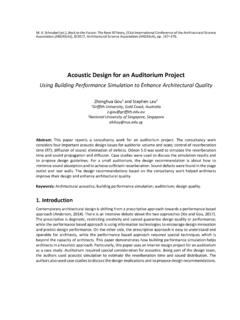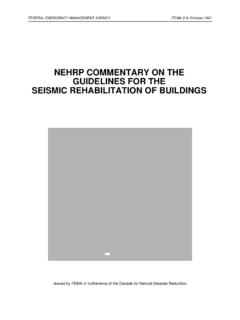Transcription of IM for procurement procuring for IM - ANZAScA
1 Crawford and A. Stephan (eds.), Living and Learning: Research for a Better Built Environment: 49th International Conference of the Architectural Science Association 2015, 246. 2015, The Architectural Science Association and The University of Melbourne. BIM for procurement - procuring for BIM Dominik Holzer The University of Melbourne, Melbourne, Australia Abstract: Contractual frameworks currently applied in Australia predate the use of life-cycle Building Information Modelling (BIM) for the delivery of construction projects. To date, little has been done to align the various contractual procurement methods in Australia with the novel opportunities offered via BIM. It is the objective of this paper to position BIM under various contract procurement methods and to hint at the possibilities for adjustment of these procurement methods in the light of collaborative work-practices.
2 The author does not claim to have extensive expertise in construction law and this paper does therefore not directly outline new forms of contractual arrangements. Instead, the author brings into perspective the opportunities and challenges of BIM under the contract procurement methods one by one. Keywords: BIM; procurement ; contract; collaboration. 1. Introduction The adoption of Building Information Modelling (BIM) in parallel with the introduction of policies and national standards that govern its use progresses steadily in an ever growing number of developed countries (McGraw Hill, 2014). As much as BIM adoption is often market driven, regulatory frameworks and in particular contract procurement methods have a major impact on the success of BIM-use on medium-to-large construction projects. Contractual frameworks applied to govern design, construction and commissioning of projects typically predate the use of life-cycle BIM for the delivery of projects (Kuiper and Holzer, 2013).
3 These frameworks may at times rather obstruct than support BIM use. Stakeholders from both project delivery as well as construction law (McAdam 2010, Chew 2010) have started to review the contract methods in the light of BIM. This paper adds to these efforts by scrutinising BIM-use under various contract procurement methods based on the common lines of reporting applied under these contracts. In particular the structure and sequence of reporting and sharing design and construction data will be analysed in the light of opportunities and challenges inherent to different BIM workflows. The method applied for the research presented in this paper is as follows: After a brief problem definition, the author draws from literature to examine current international and Australian policies and 238 D. Holzer guidelines that relate to the adoption and procurement of BIM.
4 Literature both relating to legal aspects of project procurement as well as practical aspects of project delivery has been reviewed in the light of BIM. The aim was to understand its impacts on the way stakeholders (can) engage under various Australian contract types. The author then compares the affordances of BIM to support collaboration among project stakeholders under these construction contracts. This overview is complemented by a reflection about the opportunities and constraints associated to BIM under these contract procurement methods. The author further discusses how considerations about contract procurement methods can be woven into BIM execution planning (as currently applied in practice). The paper will thereby consider the particular information requirements of each of the key parties who partake in the design, engineering, construction and operation of built assets along the way.
5 2. The BIM dilemma As much as the focus of BIM development in its early days was put on technological advance, the legal and procurement aspect soon followed as an area of interest. By the mid-2000s, BIM proponents observed that the potential of information sharing and data interoperability offered via new technology can get constraint in practice by contractual frameworks or other legal considerations. Some key topics are listed here: Holzer (2007) describes how the use of BIM affects the distribution of roles and responsibilities of individual stakeholders and he hints at possible implications for planners who need to work towards specific BIM requirements by authorities. The US Associated General Contractors of America released a ConsensusDOCS 301 BIM Addendum (2008) for construction contracts with standardised BIM terminology for stakeholder and model type definition.
6 Klimt (2011) highlights the need to resolve copyright and liability issues related to BIM models and Olatunji & Sher (2010) discuss model ownership and sharing of model data. Chew (2010) points out the limitations of BIM-use due to stakeholder focus on their individual part of the project with little consideration about process as a whole. In order to identify legal problems posed by the adoption of BIM, McAdam (2010) scrutinises UK contract procurement solutions. Further, Professional Indemnity Insurance in the context using BIM gets addressed by the UK construction Industry Council CIC (2013). The above summary is a mere snapshot of a range of publications and industry papers on the legal aspect of BIM. Considering a number of the topics listed here, the American AIA (California Council) published a document in 2007 where they promote a radical new contract procurement method with the goal to maximise the potential BIM technology can offer with a more fitting legal framework: Integrated project Delivery (IPD).
7 IPD is based on the Australian Alliancing contract model, complemented by an information management strategy that supports BIM collaboration. The AIA defines IPD as follows (2007): Integrated project Delivery (IPD) is a project delivery approach that integrates people, systems, business structures and practices into a process that collaboratively harnesses the talents and insights of all participants to optimize project results, increase value to the owner, reduce waste, and maximize efficiency through all phases of design, fabrication, and construction . Whereas Integrated project Delivery (IPD) was initially hailed as the ideal procurement method to allow teams to achieve full BIM collaboration the industry is now viewing the idea of full BIM more cautiously (Cleves & Dal Gallo, 2012). IPD as a delivery method is developing (mainly in the US); it is still the closest fit (contractually speaking) one could aspire to a contract method in the context of BIM.
8 At the same time IPD in its pure form may well be too idealistic for common adoption throughout 239 BIM for procurement - procuring for BIM construction projects globally. IPD currently gets applied under Integrated Forms of Agreement (IFOA) on a number of infrastructure projects, or by selected clients who have learned to fine-tune its use in order to manage the supply chain associated to procuring their projects (Alarcon et. al., 2011). It will require markets to mature in terms of BIM knowledge, and stakeholders to become more comfortable with novel ways of procurement . Sive and Hays (2009) assess that more and more projects are procured with reference to some elements of IPD, thereby applying impure IPD or IPD lite as a closer fit between aspiration and current market dynamics. With early excitement about IPD fading, researchers and practitioners alike increasingly turn to alternative contract types to be considered in the light of BIM.
9 For each of those, BIM can play an important role in fostering collaboration and information transfer across participating parties. 3. BIM and procurement the broader context BIM in its ideal state affects the entire project life-cycle from procurement , feasibility studies through to design, engineering, construction , operation, and demolition. The importance procurement plays as part of this cycle has long been underrated. Even further, it is not only the effects of procurement on BIM one should consider, but ultimately also the opportunities BIM offers in revolutionising the way projects are procured in the first place. The below diagram (Figure 1) picks up on some typical processes associated to BIM that can be applied across different contract procurement methods. They include the use of BIM as template for generating tender documents, tight integration from Design BIM by consultants with construction BIM by contractors and subcontracting parties, early involvement of contractors, lifecycle BIM (moving from BIM to Facilities Management - FM), and risk sharing of collaborating parties.
10 The saturation of the dot suggests the potential to facilitate these processes under common varying contract types. The author accepts that variations to these occur depending on project -specific clauses in the contract. Figure 1: Matrix of delivery method and BIM characteristic. 4. The impact of government policy and mandates It appears that one key obstacle to the propagation of BIM is a lack of client demand (Goh 2014). Historically, there is truth to that. At the same time, one cannot ignore the ever growing list of 240 D. Holzer governments, or government departments that start to ask for BIM for publically commissioned work in one way or another. These requirements/ mandates range from specific and well defined ( spatial programme validation) BIM requirements such as those brought forward in 2006 by the US General Services Administration (GSA), to the provision of major financial incentives, such as those by the Building & construction Authority (BCA) in Singapore from 2010.






